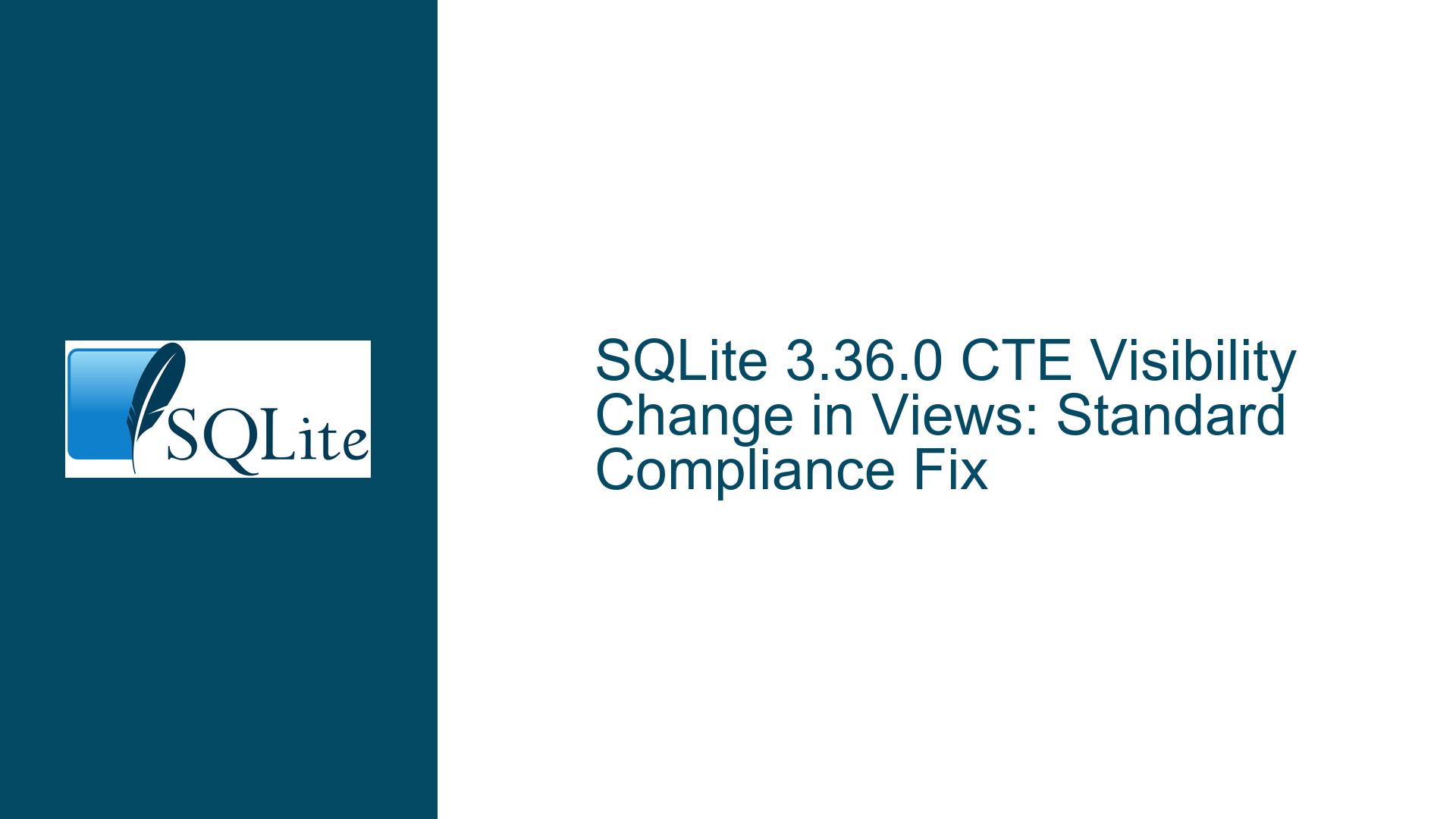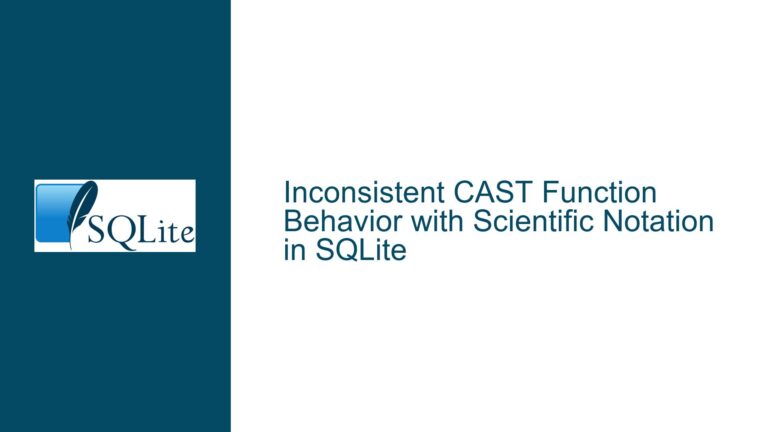SQLite 3.36.0 CTE Visibility Change in Views: Standard Compliance Fix
CTE Visibility Behavior Change in SQLite 3.36.0
A significant change in Common Table Expression (CTE) visibility rules was introduced in SQLite 3.36.0, affecting how CTEs interact with views. Prior to this version, a CTE defined in an outer query could override the visibility of a table or view with the same name referenced inside a nested view. After the update, SQLite aligns with the SQL standard by restricting CTE visibility to their immediate scope, ensuring that views resolve object names based on their original schema context rather than outer query CTEs.
Technical Breakdown of the Change
Consider the following schema and query:
CREATE TABLE t (id INTEGER);
INSERT INTO t VALUES (1);
CREATE TABLE t2 (id INTEGER);
INSERT INTO t2 VALUES (2);
CREATE VIEW v AS SELECT id FROM t;
WITH t AS (SELECT id FROM t2)
SELECT * FROM v;
Pre-3.36.0 Behavior:
The CTE t in the outer query would "shadow" the table t referenced in the view v. The view would resolve t to the CTE t (which selects from t2), returning 2. This violated the SQL standard, which mandates that views resolve object names during their creation, not execution.
Post-3.36.0 Behavior:
The view v now correctly references the table t as defined at view creation time, ignoring the CTE t in the outer query. The result is 1, matching PostgreSQL and other standard-compliant databases.
Implications for Existing Queries
This change impacts applications that relied on the non-standard behavior to dynamically redefine table references in views via CTEs. For example, a view designed to act as a "polymorphic" template using outer CTEs to swap underlying tables will no longer function as intended. Queries that unintentionally exploited this loophole may now produce incorrect results or errors.
Root Causes of Altered CTE Scope Resolution
The shift in behavior stems from corrections in SQLite’s name resolution logic for objects referenced in views. Two primary factors contributed to this change:
1. Incorrect CTE Scope Inheritance in Views
Prior to 3.36.0, SQLite’s parser allowed CTEs defined in an outer query to be visible within nested views during query execution. This violated the SQL standard’s requirement that views resolve object names statically at creation time. The bug originated from how the query planner resolved object names in views: it improperly prioritized CTEs from the outer query over schema objects (tables, other views) defined in the database.
2. Standard Compliance Prioritization
SQLite’s development team addressed this discrepancy to align with ISO/IEC 9075 (SQL Standard) specifications, which state that views must resolve all referenced objects within their own schema context. CTEs are temporary named result sets visible only within the scope of the query where they are defined. They are not part of the schema and thus should not influence object resolution in pre-defined views.
3. Silent Bug Fix with Major Impact
The correction was classified as a low-priority bug fix because it was discovered internally and had no user-reported issues. However, the fix inadvertently broke workflows that depended on the non-standard behavior. This highlights the challenge of balancing standard compliance with backward compatibility in database engines.
Troubleshooting Steps, Solutions & Fixes
Step 1: Identify Affected Queries
Queries combining CTEs with views that reference tables or views sharing the same name as the CTE are at risk. To detect conflicts:
Audit Views for External Dependencies:
Review view definitions for references to tables that might be shadowed by CTEs in outer queries. For example, a viewvreferencing tabletused in a query withWITH t AS (...) SELECT * FROM v.Version-Specific Testing:
Execute critical queries under both SQLite 3.35.5 and 3.36.0. Compare results to isolate cases where CTE shadowing previously influenced output.
Step 2: Refactor Queries for Standard Compliance
Modify queries to eliminate reliance on CTE shadowing:
Option 1: Rename CTEs to Avoid Conflicts
-- Original (problematic)
WITH t AS (SELECT id FROM t2)
SELECT * FROM v;
-- Revised
WITH t_cte AS (SELECT id FROM t2)
SELECT * FROM v;
By renaming the CTE, the view v will unambiguously reference the table t.
Option 2: Materialize Context-Dependent Views as CTEs
If a view was intentionally designed to reference outer CTEs (non-standard), inline its definition into the query:
-- Original view-based approach
CREATE VIEW v AS SELECT id FROM t;
WITH t AS (SELECT id FROM t2)
SELECT * FROM v;
-- Revised with CTE
WITH t AS (SELECT id FROM t2),
v_cte AS (SELECT id FROM t)
SELECT * FROM v_cte;
This approach explicitly binds the view-like logic to the CTE t.
Option 3: Schema-Qualify Table References in Views
While SQLite does not support schema qualifications in the same way as other databases, prefixing table names with main. (the default schema) forces resolution to the schema object:
-- Original view definition
CREATE VIEW v AS SELECT id FROM t;
-- Schema-qualified definition
CREATE VIEW v AS SELECT id FROM main.t;
This explicitly ties the view to the table t in the main schema, reducing ambiguity.
Step 3: Adopt Defensive Design Practices
Avoid Naming Collisions:
Use distinct naming conventions for CTEs (e.g.,cte_<name>) and schema objects (tables/views).Version-Specific Branching in Application Code:
If backward compatibility with pre-3.36.0 SQLite is required, conditionally modify queries based on the detected SQLite version:# Python pseudocode import sqlite3 conn = sqlite3.connect(':memory:') version = conn.execute('SELECT sqlite_version()').fetchone()[0] if version >= '3.36.0': query = 'WITH t_cte ...' # Standard-compliant else: query = 'WITH t ...' # Legacy shadowingDocument CTE-View Interactions:
Clearly annotate queries where CTEs and views interact, even if no collision exists today. This mitigates future risks if additional schema changes introduce naming conflicts.
Step 4: Leverage SQLite’s Exploitation of Standard Behaviors
For advanced use cases previously relying on CTE shadowing, consider these standard-compliant alternatives:
Dynamic SQL with Application-Side Templating
Generate SQL queries programmatically to swap table names in views:
# Python pseudocode
table_name = 't2' if use_alt_table else 't'
query = f"""
WITH v_cte AS (SELECT id FROM {table_name})
SELECT * FROM v_cte
"""
This avoids shadowing while achieving "polymorphic" view behavior.
Use Temporary Tables for Session-Lived Redefinition
-- Create a temporary table shadowing the schema table
CREATE TEMP TABLE t AS SELECT id FROM t2;
-- Query the view, which now references the temp table
SELECT * FROM v;
-- Drop the temp table after use
DROP TABLE t;
Temporary tables are session-specific and override schema tables, offering a controlled way to redefine objects.
By methodically addressing naming conflicts, adopting schema-qualified references, and restructuring queries to align with standard visibility rules, developers can ensure consistent behavior across SQLite versions while maintaining compatibility with other database systems.






